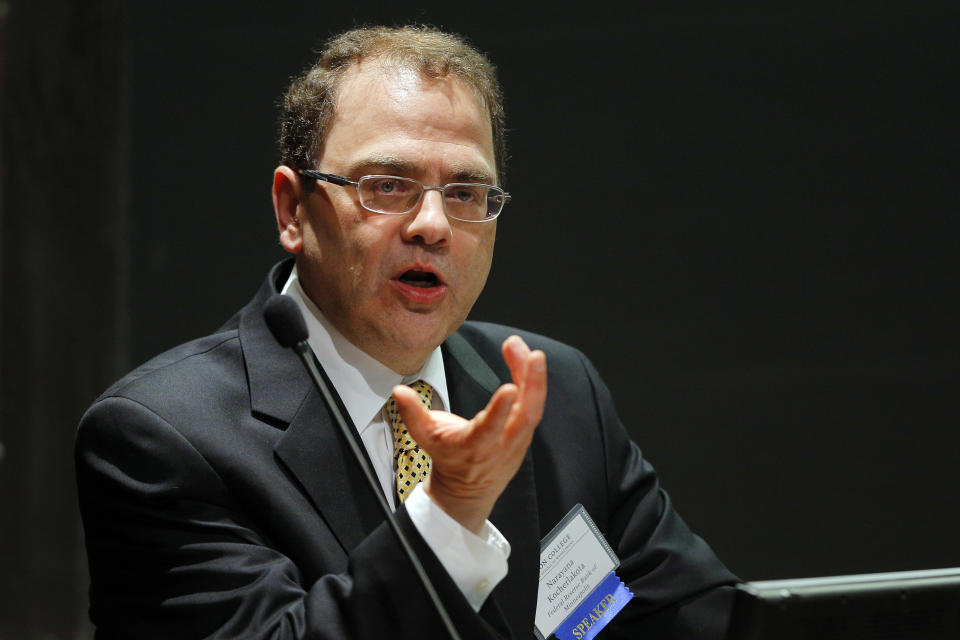Coronavirus fears raise market expectations for Fed rate cut in March
A plunge in equity markets on Monday boosted market expectations for the Federal Reserve to cut interest rates to insulate the U.S. economy from the effects of the coronavirus.
A surge in infections in Italy and South Korea over the weekend sent the Dow Jones Industrial Average down as much as 1000 points, or over 3.7%.
Fed funds futures markets dramatically increased their expectations for a Fed rate cut in the central bank’s next meeting. Heading into the day, Fed funds futures contracts were pricing in an 11% chance of a rate cut on March 18. As of 3 p.m. ET on Monday, contracts had increased their odds of a rate cut to 23%.
Earlier in the day, Former Minneapolis Fed President Narayana Kocherlakota published a piece in Bloomberg Opinion arguing that the Fed needed to call an “immediate” meeting ahead of its March date and cut rates by 25 basis points — or more.

“I don’t think that the FOMC should wait that long to deal with this clear and pressing danger,” Kocherlakota wrote. “I would urge an immediate cut of at least 25 basis points and arguably 50 basis points.”
But current policymakers have not been as adamant on wanting to adjust rates yet. After last year’s 75 basis points of “insurance” cuts to avoid adverse effects from the trade war, Fed officials indicated that they could see rates holding steady through the entirety of 2020.
The emergence of the coronavirus has sparked new concerns over whether the Fed should cut rates to again steer clear of an economic shock.
Cleveland Fed President Loretta Mester said Monday that she did not see a case yet to cut rates, adding that she would like to keep interest rates “at current levels for a time.” Speaking to reporters on the sidelines of a business economics conference in Washington, D.C., Mester said she is not inclined to adjust her monetary policy stance because of one day of market moves.
“I just caution that you don’t want to overreact to the volatility in the markets if you’re a monetary policymaker,” Mester said.

Mester notably opposed the Fed’s three rate cuts last year, saying she would have liked to see stronger evidence of the negative trade effects that Fed policymakers were trying to insure against.
‘Not 100% clear’ that a cut would help
Fed officials face the challenge of trying to quantify the economic the impact of a virus, an unusual shock that macroeconomists may find difficult to forecast.
Former Fed Vice Chairman Roger Ferguson said Monday that with respect to interest rate policy, the Fed needs to think about whether a rate cut would truly insure the U.S. economy from possible spillover effects.
“It’s not 100% clear that having interest rates 25 basis points lower is likely to have a direct impact on the ability to manufacture goods or to get people back to work,” Ferguson, now CEO of TIAA, told reporters at the same conference. “And that’s one of the questions the Fed has to think about.”
Citi Global Chief Economist Catherine Mann told Yahoo Finance Monday that her economics team has not priced in any additional cuts at the moment, but acknowledged that markets appear to be pricing in two rate cuts by the end of 2020.
“The emerging markets are not immune from this and I would argue the U.S. is not immune either,” Mann said. “[The U.S.] does seem to be the last one affected.”
The Fed’s next policy-setting meeting will take place March 18.
Brian Cheung is a reporter covering the banking industry and the intersection of finance and policy for Yahoo Finance. You can follow him on Twitter @bcheungz.
Exclusive: IMF says global economy could still see 'v-shaped' recovery from coronavirus
Economists split on whether Fed policy is 'quantitative easing'
Fed ponders financial market impacts as it considers new tools
'This is the new normal': California businesses pessimistic on phase 2 deal
Read the latest financial and business news from Yahoo Finance
Follow Yahoo Finance on Twitter, Facebook, Instagram, Flipboard, SmartNews, LinkedIn, YouTube, and reddit.
